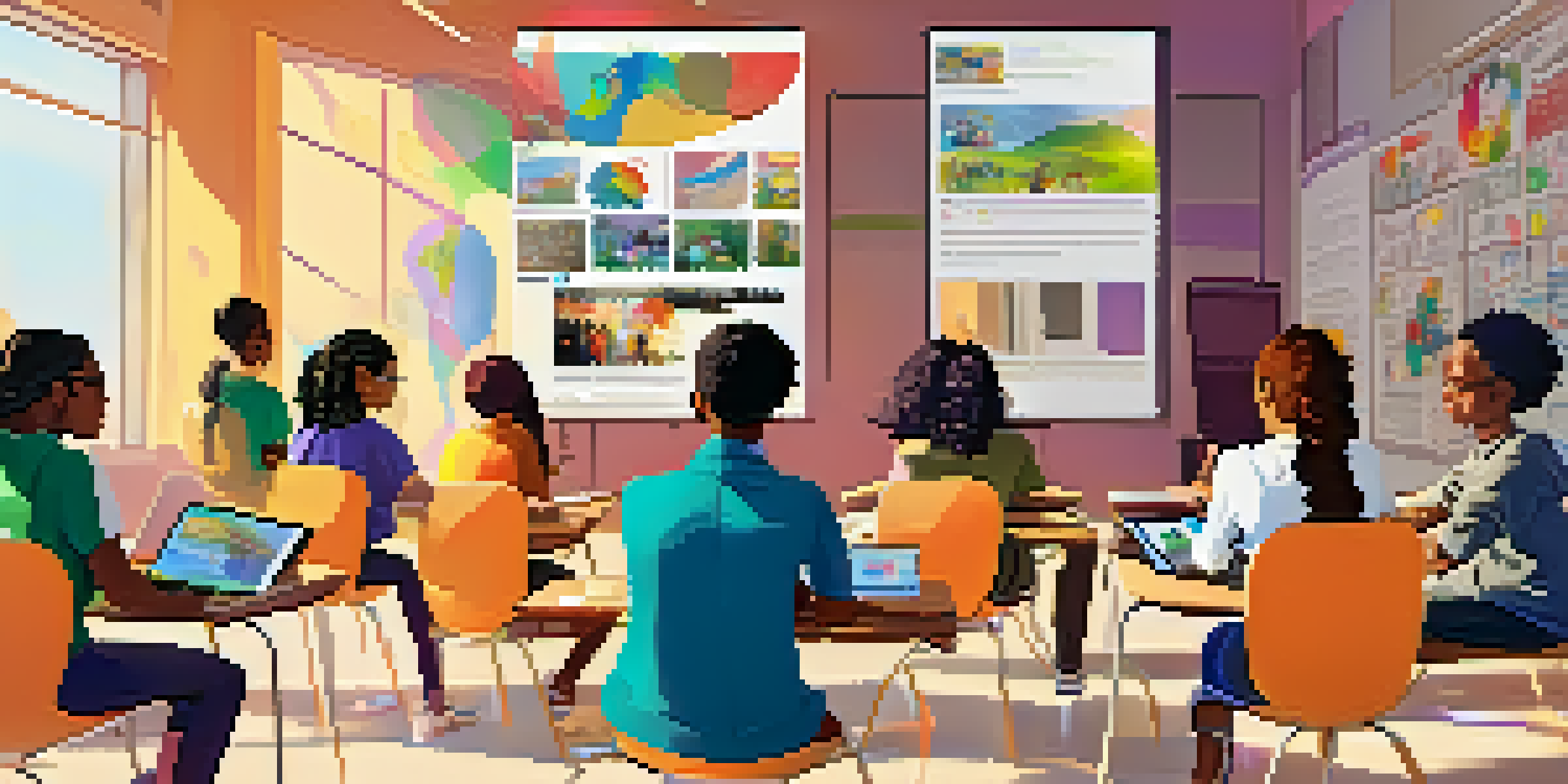Fostering an Innovative Mindset in Online Learning Spaces

Understanding the Importance of Innovation in Learning
Innovation in online learning is essential for keeping students engaged and motivated. It encourages learners to think creatively and solve problems effectively. By cultivating an innovative mindset, educators can create a dynamic environment that adapts to diverse learning needs.
Innovation distinguishes between a leader and a follower.
In today's fast-paced world, sticking to traditional teaching methods can leave students feeling uninspired. Innovation helps bridge the gap between theoretical knowledge and real-world application, making learning more relevant and exciting. This relevance not only enhances retention but also sparks curiosity.
Ultimately, fostering an innovative mindset prepares learners for future challenges. It equips them with the skills necessary to navigate an ever-evolving job market, where adaptability and creativity are crucial. As such, embracing innovation in online learning isn't just beneficial; it's essential.
Creating a Supportive Online Learning Environment
A supportive environment is the backbone of fostering innovation. In the virtual classroom, this means creating a space where students feel safe to express their ideas without judgment. Encouraging open dialogue and collaboration can significantly enhance this sense of community.

Utilizing tools like discussion forums and group projects can help facilitate interaction. When learners collaborate, they share diverse perspectives, which can spark new ideas. This collaborative spirit is vital in cultivating an innovative mindset, as it allows students to learn from one another.
Foster Innovation through Collaboration
Creating a supportive online learning environment encourages students to collaborate, share ideas, and enhance their innovative thinking.
Additionally, providing constructive feedback is key to nurturing creativity. Instead of merely evaluating performance, feedback should focus on how students can expand their thinking and approaches. This guidance can help them push boundaries and explore new possibilities.
Incorporating Technology to Enhance Creativity
Technology plays a crucial role in fostering innovation in online learning. Tools such as interactive simulations, virtual reality, and gamified learning experiences can make lessons more engaging. These technologies not only capture attention but also stimulate creative thinking.
The greatest danger in times of turbulence is not the turbulence; it is to act with yesterday’s logic.
For example, using digital whiteboards allows students to brainstorm ideas collectively, visualizing their thoughts in real time. This can lead to unexpected connections and innovative solutions. It transforms the learning process from passive consumption to active creation.
Moreover, technology provides access to a world of resources. Students can explore diverse materials and perspectives that inspire them to think outside the box. This exposure to varied information is vital in developing a well-rounded, innovative mindset.
Encouraging Risk-Taking and Experimentation
A critical aspect of fostering innovation is encouraging students to take risks. In an online learning environment, students should feel comfortable experimenting with new ideas and approaches. This experimentation is where true creativity often flourishes.
Educators can model risk-taking by sharing their own experiences with failure and success. By normalizing mistakes as part of the learning process, students are more likely to engage in innovative thinking. Celebrating these risks, no matter the outcome, fosters a culture of exploration.
Embrace Technology for Engagement
Incorporating interactive technologies in online education captivates learners and stimulates creative problem-solving.
Creating assignments that allow for flexibility and choice can also encourage risk-taking. When students have the freedom to explore topics that interest them, they are more likely to push boundaries and think creatively. This autonomy is crucial for developing an innovative mindset.
Promoting Critical Thinking and Problem-Solving Skills
Critical thinking is a cornerstone of innovation. In online learning, it’s essential to integrate activities that challenge students to analyze and evaluate information. This not only enhances their understanding but also encourages them to think creatively about solutions.
Real-world problem-solving scenarios can be particularly effective. By presenting students with challenges relevant to their lives or studies, educators can stimulate innovative thinking. These experiences allow learners to apply their knowledge in meaningful ways, fostering both engagement and creativity.
Additionally, encouraging reflective practices can bolster critical thinking. Journaling or discussion prompts that ask students to reflect on their learning processes can help them identify their thought patterns. This self-awareness is a key driver in developing innovative solutions.
Building a Culture of Collaboration and Sharing
Collaboration is vital in fostering an innovative mindset. In online learning spaces, creating opportunities for students to work together can lead to richer, more diverse ideas. This collaborative culture encourages learners to share their thoughts and build on one another's insights.
Utilizing group projects or peer review sessions can enhance this sense of community. When students collaborate, they not only learn from each other but also develop essential teamwork skills. These experiences mirror real-world scenarios, preparing them for future collaboration in their careers.
Encourage Risk-Taking in Learning
Promoting a culture of experimentation helps students feel comfortable taking risks, which is crucial for developing creativity and innovation.
Moreover, sharing knowledge and resources can inspire innovation. Platforms that allow students to showcase their work and receive feedback can spark new ideas. This exchange of creativity helps create a vibrant learning atmosphere where innovation thrives.
Emphasizing Lifelong Learning and Adaptability
Fostering an innovative mindset is not a one-time effort; it's about promoting a culture of lifelong learning. Encouraging students to be open to new ideas and approaches prepares them to adapt in an ever-changing world. This adaptability is essential for both personal and professional growth.
In online learning, educators can model lifelong learning by continuously updating their own skills and knowledge. Sharing their learning journeys can inspire students to embrace a similar mindset. This practice reinforces the idea that learning is an ongoing process.

Additionally, providing resources for self-directed learning can empower students. When they have access to courses, webinars, and materials that pique their interest, they are more likely to explore new areas. This exploration is a key component of fostering innovation.